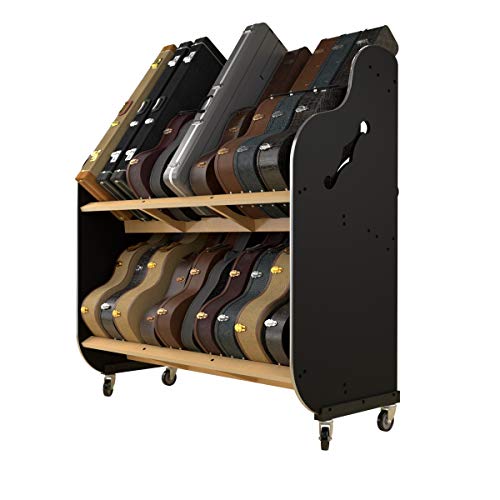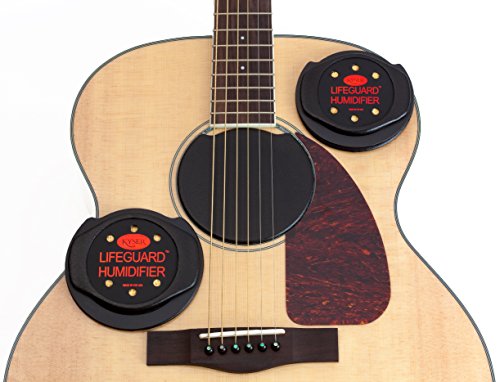How do you store your guitar after you’ve finished playing it? For many beginners, they choose to lean the instrument on a wall until returning to it.
The problem with that technique is that someone or something can bump into it. Once the instrument experiences an impact, the tuning and tone control get altered.
Even simple vibrations can cause a leaning guitar to tumble from the wall.
This guide takes you through how to appropriately take care of your instrument when it isn’t in your hands.
Leaning Your Guitar on a Wall for Storage
When storing one guitar or several, the instrument should get stored in a case. When you place them upright, like a suit jacket on a rack, you’ll keep the string tension at appropriate levels. You can also hang guitars on a wall with suitable bracket supports.
Repair shops hear frantic calls from guitar owners daily because something damaged their instrument.
Every technician can tell you about the strangest conversation they’ve ever encountered, ranging from antlers goring an instrument to one falling out of a wall bracket.
Even keeping your guitar on a radiant heat floor can cause damage to it. The temperature change can cause the body to spring apart, essentially destroying the instrument.
What is even more remarkable are the people who walked through the rain, ice, or snow with their guitars covered by a garbage bag.
When you carefully tend to your guitar, it can survive whatever weather and transportation problems come its way.
- Hardshell Acoustic Guitar Case
- Size: Dreadnought
- Perfect for Yamaha Guitars: F Series, FG Series, CPX Series, FGX Series, FJX Series, A1 Series, A3 Series,
- Inside Dimensions:
- Inside Length: 43 ½-inch
- Upper Bout: 12-inch
- Lower Bout: 16 ¼-inch
- Inside Depth: 5-inch
- Outside Dimensions:
- Outside Length: 45-inch
- Upper Bout: 13 ½-inch
- Lower Bout: 17 ¾-inch
- Outside Depth: 6 ¾-inch
Although a soft case is better than nothing at all, your guitar should be in a hard case built for its shape and design. An excellent example is the Yamaha AG1-HC dreadnought acoustic case, which works with the following models.
- Yamaha F Series
- Yamaha FG Series
- Yamaha A1 Series
- Yamaha A3 Series
- Yamaha CPX Series
- Yamaha FGX Series
- Yamaha FJX Series
Yamaha also states that their acoustic guitar hard case works with any standard dreadnought-style instrument.
If you review the dimensions offered and measure your guitar, you’ll know if this highly rated product can meet your needs.
It only takes a little thought to improve how you store or display your guitars. Even if you’re on a limited budget, there are better options available than leaning the instrument against the wall.
How to Store Your Guitar in Its Case Correctly
The safest place for a guitar is in its case. A gig bag is an alternative for the times when a high-quality hardshell isn’t available.
When you store multiple guitars together, it helps to keep them upright (vertical) instead of lying on their backs. You’ll reduce the risk of neck and fretboard damage by using that technique.
You’ll want to position your guitars in such a way that they won’t fall over like dominoes if someone or something bumps into them.
If you have limited space at home, the best investment you can make for storing your guitar correctly is a vertical stand.
■ String Swing Store Guitar Stand
When you select this guitar stand, you’ll have enough room for three acoustic models or six electrics. It automatically holds your instruments in the preferred vertical style, keeping them side-by-side for convenience.
If you have acoustic and electrical models, there’s enough room for two electrics and two acoustics with the design.
You can set up the hardwood frame with high-density rubber almost anywhere. The design of the String Swing Store guitar stand protects the instrument’s finish while safely holding it upright.
When you’re ready to play, grab your guitar and go! Some assembly is required, but it only takes a screwdriver to finish the work.
■ Session Pro Double-Stack Mobile Case Rack
The problem with an open guitar case stand is that it leaves your instruments exposed. It keeps them in the upright position, but it won’t stop significant impacts to the frame that could damage your investment.
That’s why your best guitars need to stay in their hardshell while in vertical storage.
When you select the Session Pro double-stack mobile case rack, you’ll have enough room to store about 24 instruments while keeping them protected in the hardshell.
If you have other instruments to protect, they’ll fit in there with your guitars without difficulty.
The design includes heavy-duty casters that let you push the storage product over any surface. It will keep your music room or studio organized!
Even if your guitars are in a hardshell case, they should not be stacked horizontally. This technique increases the pressure placed on the instrument.
Your only horizontal option is to have shelving available that enables you to place one guitar per shelf.
How to Prevent Damage to Your Stored Guitar
If you plan to store a guitar in its case for 12 months or less, you’ll want to protect the instrument from tension changes that can happen with the strings.
You’ll want to loosen all of the strings by at least a half step before storing the guitar. If you have cheaper steel products on your instrument, it might be worthwhile to go a whole step instead.
When you plan to keep a guitar in storage for more than a year, you should make the strings as slack as possible to protect your investment.
You’ll want to use the minimum tension required to hold the bridge pins, saddle, and nut in place.
If the truss rod can stay in a neutral position while in storage, it’s much easier to return the guitar to playing condition when it comes out of its case again.
You’ll also need to think about humidity control when storing your guitars.
Whether it’s a few days or a few months, the moisture and heat found in your home’s environment can cause the instrument to start coming apart.
Even if it stays together, the guitar’s wood expands with heat and humidity to alter the playing tone you get.
- Small Size
- Great Accuracy
- Records Highs and Lows
- Measures Temperature in °C or °F
Some cases come with a built-in hygrometer and humidifier to ensure your guitar stays in a safe, playable condition.
- Automatic Humidification
- With Bluetooth Sensor That Lets You Track and Monitor Humidity
- Humiditrak App
- Includes 3 Packets
You can adjust the case’s environment by adding products like the D’Addario two-way humidification system and its conditioning packets.
It’ll maintain a proper environment until you’re ready to start playing again.
- Perfect for Acoustic Guitars
- No More Cracking
- Fits 3 3/4" to 4 1/8” Sound Holes
You can also use the Kyser Lifeguard system for guitar humidification. It prevents the wood from drying out and cracking by fitting into the instrument’s soundhole.
The acoustic guitar model fits spaces with a 3.75-inch to a 4 1/8-inch opening.
The humidification systems often work with classical and electric-acoustic designs, but you’ll want to verify the product’s specs before applying it to your instrument.
■ You Must Continue to Watch Humidified Guitars
The problem with guitar humidification is that it can cause standing water issues in some instruments. When there’s persistent environmental moisture, mold and mildew can form on hard surfaces.
That means you can experience growth on the outside of your guitar’s finish if it forms.
When that issue occurs, the mold and mildew can destroy the lacquer or work their way into the instrument’s unprotected body.
It is essential to remember that excess moisture can ruin a guitar as fast as excessive dryness.
- 3000+ sqft Depending on the Model
- Water Capacity: 12 Gallons / 45.42 Liters Per Day
- Maintains a 34% - 45% Humidity Level
- With Digital Controls
- Air Flow Capacity: 200 Cubic Feet/ 5.66 Cubic Meters per Minute
If you don’t like the idea of humidifying individual guitars, it might be worthwhile to install a whole-house humidifier instead.
By the time you purchase the product and get it professionally installed, you’ll have spent about the same amount as you would for individual cases and protections.
With a whole-house humidifier, you’ll gain the added benefit of using evaporative steam. That humidification style dramatically reduces mold and mildew risks.
How to Store a Single Guitar Correctly at Home
Although you could install guitar holders on your walls to have a meaningful place for your instruments, that approach isn’t practical for players with only one.
When you only need to store one guitar, don’t lean it in a corner or against the wall to get it out of the way. You’ll still be risking damage!
The best solution for individual guitars is a floor stand. It’ll allow you to display the instrument, have it available for immediate playing, and have several designs from which to choose.
Your best option for a floor-based guitar stand is a high-quality A-frame.
- Made of Solid Acacia Wood
- Universal: Fits Guitar, Ukulele, Bass, and Banjo
- Foldable
- Weight: 28.21 ounces / 800 g
I highly recommend using the Donner wooden guitar stand if you find yourself in that situation. It’s made from solid acacia wood, providing more stability and substance to protect the instrument.
The manufacturer uses a universal design that works with almost any style, and it’s even usable for banjos, mandolins, bass guitars, and electric models.
Additional choices to consider are the MIMIDI acoustic guitar stand, the CAHAYA universal wooden guitar stand, and the Fender universal A-frame floor stand.
Each of these offers the capability of protecting your instrument while keeping it on display.
■ Guitar Floor Stand Options Other than an A-Frame
The one issue with a standard A-frame stand is that most designs aren’t adjustable. If you need more flexibility for your instrument, you’ll want to consider a tripod stand for your guitar instead.
I highly recommend the Hercules GS41B A/G guitar stand if you prefer the tripod design. It stands out because of the AGS yoke system, which is the same choice you’d use for displaying the instruments on a wall.
The manufacturer uses SFF rubber to protect the finish against the legs, and the entire system supports up to 33 pounds.
You might find the GS100 guitar stand from Ultimate Support to be a better fit in some situations or as a tripod alternative.
Do You Need a Creative Guitar Storage Solution?
When the conventional options for guitar storage aren’t meeting your needs, it’s time to get creative!
You might not have the room to store your guitars vertically, even if using a stand that doesn’t require the instrument to be in its hard case.
In that situation, your DIY skills could produce a custom frame with similar capabilities.
When your guitars cost as much as a year’s college tuition, it might be better to put your instruments in an environmentally protected safe.
Some people build fake walls in their closets or music rooms to protect their investments.
It helps to balance your approach to protection with having the instrument displayed. When you can pick up a guitar when there are a few free moments, you can play a song or tinker with a melody and have fun.
If your storage methodology is cumbersome, it won’t be as easy to access the instrument. Although it might be tempting to lean it against a wall, it’s better to choose a floor stand that protects your guitar.









